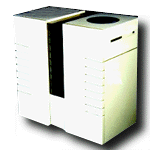 Hewlett-Packard SureStore Optical
80fx/160fx/200fx Jukeboxes
Hewlett-Packard SureStore Optical
80fx/160fx/200fx Jukeboxes
Product Information
HP optical jukeboxes provide immediate access
to large volumes of information that is traditionally
stored on paper or microfiche.
Optical jukebox storage allows significantly faster
and more efficient data retrieval than off-line
systems, making information available online to multiple
users at a low cost-per-megabyte. Optical jukeboxes eliminate the
barriers to off-line information, so large amounts of historical data can
be managed and retrieved in seconds. Valuable documents
are no longer lost, mis-filed, or damaged.
Features and Benefits
HP's improved jukebox design gives our customers
what they are asking for:
Increased Capacity
Double the read/write performance with 2.6-Gbyte disks, and up to 4 drives.
Superb Performance
Up to 4 independent drives means fewer disk swaps and more data
under the head. Online drive replacement allows a drive to be
replaced while the other drives continue to read and write data,
greatly reducing jukebox downtime.
Choice in Numbers of Drives and Optical Disks
80fx: 83.2GB, 32 disks, 2 drives
160fx: 166.4GB, 64 disks, 4 drives
200fx: 197.6GB, 76 disks, 2 drives
Expandability
The Model 80fx is expandable to a Model 160fx or 200fx with upgrade kits, installable on-site.
Solutions Available
HP works closely with leading software providers to offer a full
line of integrated software solutions.
Product Specifications
Technical Information
Description
Model 80fx:
83.2GB magneto-optical disk jukebox (32 slots, 2 drives).
Model 160fx:
166.4GB magneto-optical disk jukebox (64 slots, 4 drives).
Model 200fx:
197.6GB magneto-optical disk jukebox (76 slots, 2 drives).
Jukebox
Disk Exchange Time
10 s
(The time it takes to stop reading data on a disk, exchange disks, and
begin reading data on another disk.)
| HP Optical Drive | |
| Average Seek Time | 25 ms |
| Short Seek (across 2.2 Mbytes) | 6 ms |
| Average Latency | 10 ms |
| Average Access Time | 35.0 ms |
| Average Access Time | 14.5 ms |
| Effective Access Time* | 3000 rpm |
| Rotational Speed | |
| * Results of 1/3 stroke plus latency over 50MB bandwidth | |
| Data Transfer Rate | |
| Reads (max. sustained) | Up to 3.4 Mbytes/s |
| Writes (max. sustained) | Up to 1.7 Mbytes/s |
| Burst (synchronous) | 5 Mbytes/s |
| Burst (asynchronous) | 3 Mbytes/s |
| Read/Write Error Rate | < 1 per 100 trillion bytes |
| Data Load/Unload Time | |
| Load (w/spin-up) | 5.5 s (avg) |
| Unload(w/spin-down) | 3.0 s (avg) |
| Buffer Size | 1 MB |
| Read Buffering | Read aheads |
| Write Buffering | Immed. report/Write Re-ordering |
| Dimensions | |
| Height | 914 mm (36.0 in.) |
| Width | 863 mm (33.9 in.) |
| Depth | 482 mm (19.0 in.) |
| Weight (Net) | 100 Kg (220 lbs.) |
| Weight (Shipping) | 127 Kg (280 lbs.) |
| Product Certification | |
| Safety | UL 1950, CSA 950, TUV IEC 950 |
| Emissions | FCC Class "A", CISPR 22, Class "A" |
| Laser | CDRH, IEC 825 |
| Reliability and Service | |
| MSBF (robotics) | 2 million swaps |
| MSBF (drive) | 600,000 swaps |
| MTBF (robotics) | 100,000 hours |
| MTBF (drive) | 100,000 hours |
| Mean Time to Repair | 30 minutes |
| Preventive Maintenance | None required |
| Environmental Specifications | |
| Temperature | |
| Operating | 10° C to 40° C |
| Non-Operating(without media) | -40° C to 60° C |
| Gradient | 10° C per hour |
| Transportation(< 14 consecutive days) | -30° C to 60° C |
| Humidity | |
| Operating | 10% to 90% RH |
| Non-Operating(without media) | 5% to 95% RH |
| Shock | |
| Non-Operating | 10 cm tilt, drop test |
| Vibration (5 to 500 Hz) | |
| Operating | 0.21 g rms |
| Non-Operating (random) | 2.1 g rms |
| Non-Operating (swept-sine) | 0.5 g (0 to peak) |
| Power Requirements | |
| Line Voltage | 100 to 240 Vac |
| Line Frequency | 50 to 60 Hz |
| Power Consumption | 210/240 W typical, 250/275 W maximum |
| Interface | |
| SCSI-2 | single-ended or differential (user-selectable) |